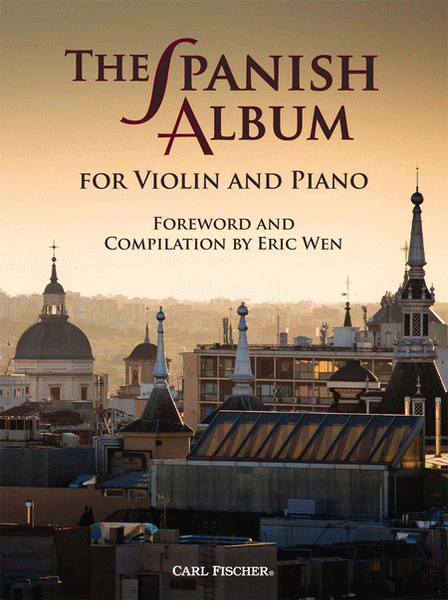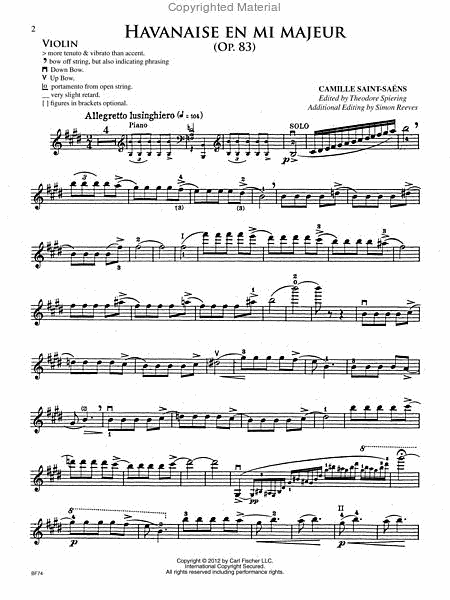The Spanish Album
For violin And Piano
-
Ships in 1 to 2 weeks
Details
Description
SKU: CF.BF74
For violin And Piano. Composed by Camille Saint-Saens, Enrique Granados, Jeno Hubay, Jose Aviles, Moritz Moszkowski, and Pablo de Sarasate. Edited by Alexander Lehmann, Gustave Saenger, and Simon Reeves. Arranged by Eric Wen. Back To School. Collection - Score and Parts. With Standard notation. 164+68 pages. Carl Fischer Music #BF74. Published by Carl Fischer Music (CF.BF74).ISBN 9780825889707. UPC: 798408089702. 9x12 inches. Transcribed by Jacques Thibaud Albert Stoessel.
Classical music in Spain underwent a resurgence in the mid-nineteeth century, and the nationalisticemphasis of the Romantic era certainly provided fertile ground for the use of the unique sounds ofthe Iberian Peninsula.In the realm of violin music, Pablo de Sarasate’s compositions revealed Romantic Spain to muchof the world and were inspirations for many other composers’ violin works in the same vein. EricWen’s compilation “The Spanish Album” is a great representative survey of this trend. His forewordprovides a lively and informative background for the pieces and composers in the book.
When we think of Spain and the violin, it is the nameof Pablo de Sarasate (1844-1908) that immediatelycomes to mind. Born in Pamplona, northern Spain,Sarasate began studying the violin with his father at theage of five. After giving his first public concert threeyears later, he was awarded a scholarship to study at theMadrid Conservatory. Queen Isabellla presented theyoung prodigy with a Stradivari violin when he was ten,and two years later, in 1856, he went to Paris to studyunder Jean Delphin Alard at the Paris Conservatoire.In less than a year he was awarded the premier prix.The year after, he was awarded the premier prix insolfège and harmony, completing his musical studiesat 15. Over the course of his career, he toured manyparts of the world, performing throughout Europeand North and South America, even touring the FarEast.According to George Bernard Shaw, Sarasate “leftcriticism gasping miles behind him.” His elegantplaying, characterized by a fleet virtuosity combinedwith immaculate intonation, was dazzling. No lessa figure than Leopold Auer remarked that Sarasate“played without any effort at all, touching the stringswith a magic bow in a manner which had no hint ofthe terrestrial.”Sarasate did not teach, and thus left no “school.”Nevertheless, he inspired a host of composers to writeviolin pieces dedicated to him, such as Bruch (SecondViolin Concerto and Scottish Fantasy), Saint-Saëns(First and Third Violin Concertos and Introductionand Rondo capriccioso), Lalo (Concerto in F minorand Symphonie espagnole), Wieniawski (Second ViolinConcerto), and Joachim (Variations in E minor).Sarasate himself contributed immensely to the violinrepertoire, with 54 opuses published in his lifetime.He composed many fantasies on operas, includingVerdi’s La forza del destino, Mozart’s Magic Flute and DonGiovanni, Gounod’s Roméo et Juliette and Faust, Weber’sFreischütz, Flotow’s Martha, and Bizet’s Carmen. Butit is his eight Spanish dances, composed in the early1880s and published in pairs, as well as the Capricebasque, that have endured. Not only do they capturea distinctive Iberian flavor, but they imaginativelyexploit the brilliance of the violin.The other virtuoso violinist-composer featured inthis collection is Jenö Hubay (1858-1937). Born inBudapest, Hubay studied in his late teens with JosephJoachim in Berlin. A fortuitous meeting with FranzLiszt resulted in the master pianist taking the youngviolinist under his wing. Not only did Liszt performwith Hubay in recitals, but he also arranged concertsfor his younger colleague in Paris. Henri Vieuxtempsheard Hubay at one of these, and was extremelytaken with the young Hungarian’s playing. Heenthusiastically promoted his younger colleague and,after his death in 1881, Hubay became the executor ofhis estate. Hubay also took over Vieuxtemps’s pupilsat the Brussels Conservatory, and completed theelder master’s unfinished Sixth and Seventh ViolinConcertos.In 1886 Hubay returned to his native city of Budapestto teach at the Academy of Music. He helped establishthe Hungarian school of violin playing, and numberedJoseph Szigeti, Zoltán Szekély, Emil Telmanyi, StefiGeyer, Jelly d’Arányi, Ilona Feher, André Gertler, andEugene Ormandy among his students. With DavidPopper, he also established the original BudapestQuartet, known in Hungary as the “Hubay-PopperQuartet.”Despite his activities as a pedagogue, Hubay remainedactive as a solo performer throughout his life. Hechampioned the works of Brahms, and gave thepremiere performances of the Piano Trio No. 3 andViolin Sonata No. 3 with the composer at the piano.Hubay was himself a prolific composer, with over 200short violin pieces to his credit. He also wrote severaloperas, including one based on the life of AntonioStradivari, known as “The Violin Maker of Cremona.”Hubay’s Fantasy on themes from Bizet’s Carmen was writtenin 1878, just three years after the opera was premieredin 1875 (Bizet died three months after its disastrouspremiere). Dedicated to Vieuxtemps, Hubay’s“Carmen” Fantasy was the first of many virtuoso worksbased on themes from Bizet’s masterful opera. Unlikethose by Sarasate and Waxman, however, Hubay’s“Carmen” Fantasy features Micaëla’s tender aria, andends with a brilliant rendition of the Toreador Song.Camille Saint-Saëns (1835-1921) was one of the mostphenomenal child prodigies in the history of music.Dubbed the “French Mozart,” Saint-Saëns was aprolific composer, brilliant pianist and organist, andoutstanding conductor. His compositions stand outfor their lyrical beauty and impeccable craftsmanship,and he wrote exquisitely for the solo violin. HisIntroduction and Rondo capriccioso and Third ViolinConcerto are in the repertoire of all the major soloviolinists. Saint-Saëns also wrote a great deal amountof chamber music for the violin, including two duosonatas with piano, as well as an exquisite Fantasy forviolin and harp.Saint-Saëns’s Havanaise for solo violin and orchestrais one of his most beloved works. As expected fromthe root of the word itself, the dance originated fromthe capital city of Cuba. The basic habanera rhythmis in duple meter with a dotted eighth and sixteenthon the first beat, followed by two even eighth noteson the second. (Sometimes a triplet replaces thedotted rhythm on the first beat.) Saint-Saëns employsthese rhythmic patterns imaginatively throughoutthe Havanaise, but also contrasts them with virtuosopassages.Although remembered today as a pianist andcomposer, Moritz Moszkowski (1854-1925) was alsoan accomplished violinist. As a pianist he studied atthe Neue Akademie der Tonkunst in Berlin, wherehe was appointed – while still a 17-year-old student– as a professor at the same institution. He was no lessaccomplished as a composer, and his Piano Concertowas greatly admired by Liszt, who performed the twopianoversion of the work with Moszkowski on severaloccasions.Due to health problems, Moszkowski retired fromthe concert stage in the mid 1880s. He continuedcomposing, and also took up conducting. In 1897,he settled in Paris, where he met and married CécileChaminade. As a teacher Moszkowski taught JosefHofmann, Wanda Landowska, and Joaquin Turina.Sadly, after the First World War, Moszkowski’sfinancial investments became worthless, and he diedin poverty.Moszkowski’s popular piano pieces – such as the Serenataand Guitarre – are delightful miniatures that are stillperformed in solo piano recitals. Paderewski wrotethat “After Chopin, Moszkowski best understands howto write for the piano.” But Moszkowski also composedseveral ballet scores and an opera. His Five SpanishDances, Op. 12, included here, were originally writtenfor piano four-hands, and transcribed for violin andpiano by Philipp Scharwenka.Enrique Granados (1867-1916) was Spain’s leadingcomposer. He was also a distinguished conductorand pianist (Ricardo Viñes was one of Granados’spupils). His two Spanish Dances included here aretranscriptions. The Spanish Dance entitled Anoranzais a transcription by Albert Stoessel of the second ofSix Pieces on Spanish Folksongs, and the SpanishDance in D, known as Jota (Rondalla aragonesa), is thesixth of twelve Danzas españolas originally publishedin 1890. The latter arrangement was made by JacquesThibaud, the great French violinist who was also amember of the remarkable piano trio with AlfredCortot and Pablo Casals.Three other Spanish flavored works round out thiscollection. Fabian Rehfeld (1842-1920) was a Germanviolinist who studied with Grünwald and Zimmermanin Berlin, and served as concertmaster of the RoyalCourt Opera for a quarter of a century. The Mexicancomposer José Aviles’s La Media Noche was written torepresent his country at the New Orleans World Fairin 1885. As one of Mexico’s leading composers, Avileswould also represent his native land at the famousParis Exhibition of 1889.5BF74.


 Share
Share